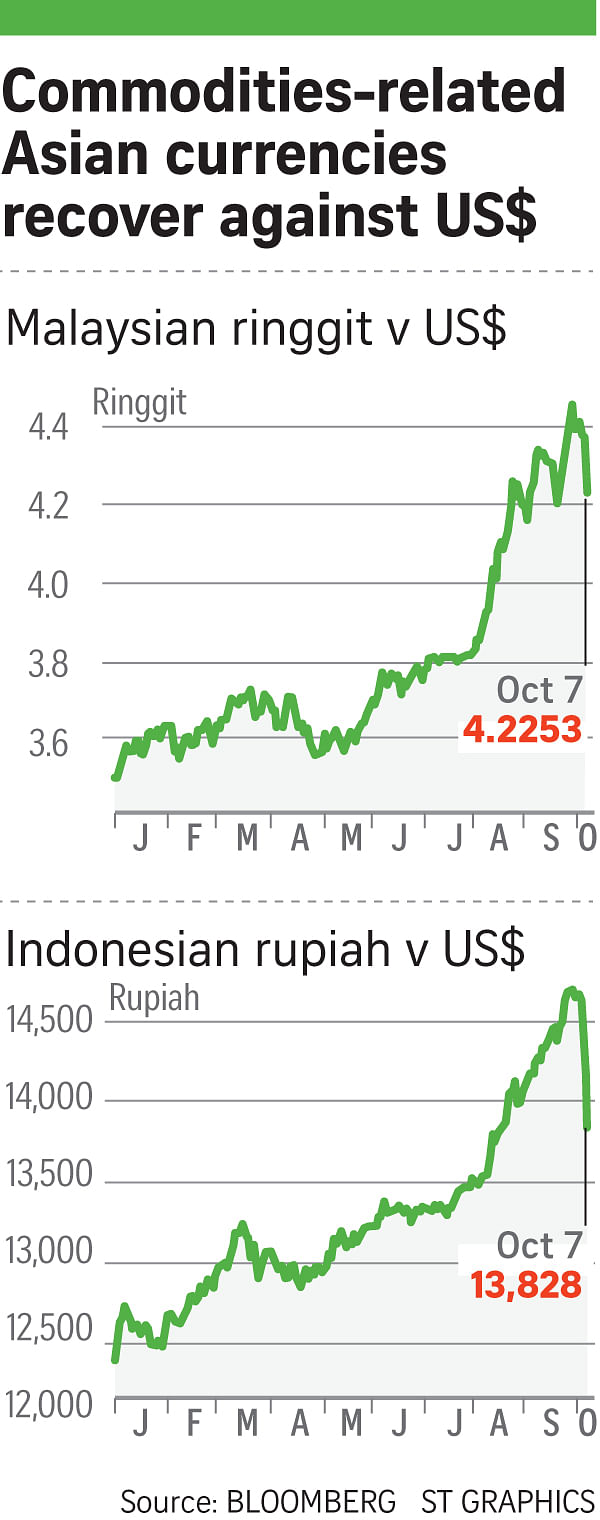SINGAPORE - A resurgence in oil prices and shrinking bets of an interest rate hike this year have helped heavily battered energy-driven Asian currencies regain ground against the greenback and Singdollar.
A softer US dollar helped lift gold to a seven-week high of US$1,148.65 an ounce as the International Monetary Fund warned of a possible global recession ahead.
Across Asia, energy shares surged, lifting Hong Kong 3.1 per cent and Japan 0.8 per cent. The benchmark Straits Times Index rallied 2.2 per cent yesterday and has gained 6 per cent since Friday when the release of disappointing US job data pushed back expectations for a Fed rate rise to next year.

The Malaysian ringgit headed for its biggest three-day rally in two years as trade data trumped estimates and Brent crude surged above US$50 a barrel. The rupiah headed for its largest four-day rally in six years as Indonesia rolled out its third stimulus package on Wednesday (Oct 7).
Brent rose to US$52.80 on Wednesday, extending gains of more than 5.4 per cent on Tuesday, after the US Energy Information Administration released new forecasts showing higher expected global demand and almost flat US production growth next year.
News that Malaysia's exports rose 4.1 per cent year on year, as its trade surplus widened to RM10.2 billion (S$3.3 billion), beating forecasts, also fuelled the ringgit's recovery to 4.2253 to the US dollar, from 4.4565 on Sept 29.
The rupiah recovered to 13,828 against the greenback from 14,698 on Sept 28. Against the Singdollar, the ringgit strengthened to 2.9909 yesterday from 3.0670 on Tuesday; while the rupiah recovered to 9,776.54 from 10,356.24 on Sept 17.
Mr Heng Koon How, senior FX strategist with Credit Suisse Private Banking & Wealth Management, cautioned against chasing the rebound in Asian currencies as "previous negative cyclical and fundamental drivers have not gone away".
He added: "We do not think this rebound in crude oil or energy prices is sustainable. Long-term oversupply issues remain."
Mr Sim Moh Siong, senior currency strategist, Bank of Singapore, warned: "Weakening pressure on EM (emerging market) currencies will likely persist amid headwinds from China."
Meanwhile, gold spiked 3.8 per cent to $1,148.65 an ounce from $1,107.03 last Friday, and is up nearly 1 per cent from Tuesday.
"I believe investors have also been buying gold as a bit of a safe-haven... so we have seen inflows into ETFs over the past few weeks," Mr Victor Thianpiriya, commodity strategist at ANZ Bank told The Straits Times.
"Gold holdings in the SPDR Gold Trust have risen from 670 tonnes in mid-August to 690 tonnes currently. China has also been importing more gold, particularly in September amid strong onshore premiums, so physical demand is supportive," he said. "Near-term, I wouldn't be surprised to see US$1,180 an ounce if the USD remains soft and if US data keeps printing on the weak side," he added.


